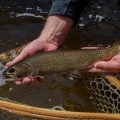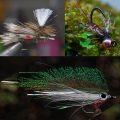How to Tie the Glitter Bug
Producer: tightlinevideo
What I’m going to tie here today, it’s called a Glitter Bug, a real common fly here in Newfoundland.
It’s fairly simple to tie, it’s sort of a variation on a Bomber and it starts with this. I’m just going to use a size 8 salmon hook here, real important here in Newfoundland, barbless hooks only so I’m going to mash the barb, just get that flattened down real nice. Then get the hook firmly secured in the jaws of my tying vise, just like that.
Alright, just for tying thread, a little light gel spun thread. I do like the gel spun for tying deer hair. It’s nice and strong, little slippery. It doesn’t cut real well with scissors, that’s why I’m using a little razor blade to cut it. I’m just kind of filling in the space behind the hook eye return there, it’s a very traditional Salmonfly.
And so the reason it’s called a Glitter Bug is that it’s got a little bit of Krystal flash in it, Pearl Crystal flash. But I’m going to tie that in second or just over top of some some calf tail, calf tail or kip tail.
I’m going to keep this tail fairly short, just strip out the lower, fuzzy stuff. I’m making a big old mess of my tying table, and I am going to stack this just to get the tips aligned. The tail, again, is fairly short, and I want it to look somewhat even. I usually don’t stack for flies like this but we’re going to here. So what I’m going to do is get that—I only want it to be about a hook gap in length for that little tail and I greatly prefer to trim to length before I tie in, rather than after the fact. I give my bobbin a little counter clockwise spin. It’s going to make the thread jump rearward and catch that calf tail and then just wind all the way back, right to the start of the bend which is about halfway between the hook point and what was the barb. Then I’m going to go back up, and I can do this because of that hook return. I’m just trying to fill in the space along the shank of the hook.
Not much flash, you don’t really want to overdo it with the flash here. Krystal flash shows up really really well in the water and too much is just too much, so I’ve got four strands there. So, kind of the same thing, set it there right at the return. What I do is I pull the Krystal flash up and toward me and what that does is it allows the Krystal flash to land right on top of the shank as opposed to being pushed by the tying thread to the far side of the hook. It really helps out. The other thing, just to kind of save on Krystal flash, I don’t like wasting materials, one of the things I do is I’ll use plunger-style hackle pliers and get hold of the material right there and then snip the Krystal flash off to length. And that way I keep those strands all together, and I can easily find them on my tying bench and use them for the next Glitter Bug.
Ok, the butt of this fly you can use chartreuse or light green deer hair if you’d like. A lot of people use very fine micro-chenille, that’s what I’m going to use here. I’m just going to get that secure. I’m going to put this right on top of the shank. You don’t want it all that long, and I’m going to try to just keep the chenille together in a bunch, again just so I’m not wasting materials. This way I can just snip it off and have the rest ready to go. Just about like that.
OK there are so many different ways to tie Bombers. My method is a little different than most people but bear with me and I’ll kind of try to explain why I do what I do. I am going to start at the rear of the fly with the deer hair. This is deer belly hair. It’s very hollow so it flares, makes a nice kind of floaty body on the fly. This is a nice clump of deer hair, very traditional deer belly hair, traditional color green. Anyway, I’m going to take a fairly ample clump of it. Really hard to tell you exactly how much I’m snipping off here. Anyway, some deer hair has a lot of wispy stuff in it, this is pretty good I’m not even having to clean it, believe it or not. I’m just going to start to spin it on the hook shank. So I’m going to take a nice little wrap, a little tension on it, take my second wrap, same spot, and then just let that deer hair spin around the hook shank like that.
Now, the next part you can use all sorts of different things, you can use a whip finish or a little half hitch tool, if you will, sometimes you can use the end of the bodkin to fit over the hook eye. I don’t think that one will, but I just have these little tools that I’ve made, they’re just hollow tubes, it just helps me to pack that hair on there and get it swept back and then bring my thread up in front so I’m ready to tie in the next clump basically—that’s all nice and packed together too—see if I can do this with just two clumps.
You guys may notice I’m using larger tying scissors here. When you’re cutting a lot material like this you don’t want to use your really fine-point scissors like that, it really dulls it very, very quickly. I’m going to pull some of that fluff out of there. And, again, same procedure, lay the bundle on the near side of the hook, kind of a loose collecting wrap and then another one which layers and spins the hair all the way around. I’m just going to kind of see where I am at this point whether I may need another smaller clump. That one really compressed on there so I am going to put another little clump on there. I don’t want to crowd the hook eye, that’s kind of a big deal here, so leave some room. So third clump but a little smaller. You know spinning deer hair like this, it’s seems like a kind of a hassle, it’s a lot of work, time-consuming, and things like that, as compared to say other flies, but in the end it it really is kind of fun and the end result is always pretty neat. So we’re looking pretty good here.
What I’m going to do now is I’m going to use that same little tube tool and I’m just going to run some half hitches into here because I do like taking the fly out of my tying vise in order to trim it. So I’m going to pull this out and this is where you start to make just a really big mess of your tying table. So I definitely don’t want to snip that beautiful little calf tail off. Some people put tape over it, which works really well if you want. I’m just going try to be careful here. And generally I just cut kind of a square rectangular shape. I do want to go along the very bottom of the shank because you don’t want to block the hook gap here too badly. You can also use a razor blade to do this, a double edge razor blade they’re very very sharp. It works well, but with that it’s so easy to trim too much and we definitely don’t want to do that. So I’m just going to get that clip to shape. Sometimes it’s easier to go back to your vice for the fine work, just to get it to be held steady. I’m going to get a pair of curved-blade scissors here, just sneak in there, trim that stuff off to make that bright chartreuse chenille butt more visible on the fly. It’s surprising how much deer hair you actually have to cut off to get them down to about the right shape. They do not have to be real big and bulky. You don’t want to cut too far down or you’re going to end up cutting down into your tying thread, or worse yet almost having that tying thread be visible through the deer hair. Kind of a big no-no with these things.
Ok we’re ready to go. Next step I going to change the color of my tying thread. I’m going go with black just to finish the head of the fly off. I’ve been using that white gel spun. This is just a regular black thread, I think a Veevus 10/0 maybe. Get that started behind the hook eye. This is where, you know tying in the hackle, a lot of people do it differently than I do but this is just the way I’m used to doing it. Anyway, I have a nice short brown hackle from a beautiful hackle cape. OK let me measure this for you, so this is size 8 hook and we want the hackle to be fairly short. The hackle feather measures out to about a size 12 and even though it’s that small, it’s also going to burrow down into this deer hair quite a bit so it’ll appear even smaller. This fly does not need a huge hackle on it, in fact it’s more desirable to be small. And a little tricky to get this tied in. Just make sure that that’s lashed down really really well, we don’t want that pulling out. And I’m going reach in with my fine scissors and snip that off as close as possible, hopefully not snipping my tying thread in the process.
Now, what I like to do here is, I’m going take my bobbin and I’m going spin it clockwise, as if you’re looking down on it, this cords up the thread, makes it nice and small and strong. And I’m just going to take the thread and wind it, kind of wiggle it through that deer hair, just a little spiral wrap. And hopefully you won’t see any of the thread going through there because it’s just burrowed down in, or not that much anyway. And then I can take my hackle and kind of do the same thing. I am going to take one full wrap in front, just a flat wrap in front, and then start. I’m using quite a bit of tension to pull that hackle stem down into the deer hair. Keep that hackle stem nice and protected and come up and around. Right before we get to the chenille, take three wraps and get that secured back there like that. And then most of the time you say a little prayer, hope for the best, and just break that hackle point off. It’s a little easier than going in and snipping it.
Then I’m going to do the same thing. I’m going to wind back through the deer hair, pulling nice and snuggly down, getting the thread burrow into the hair, and what we’re also doing here, real importantly, is cross wrapping that hackle stem. And you know if a trout or a salmon got a tooth in there, they could break that delicate stem. So when you cross wrap it you really strengthen it.
All right, we’re almost there guys. Just a little whip finish. Three or four turn, back to front whip finish, just snip or cut that tying thread free. Take a look at the other side, looks pretty good and then I’m just going add a little head cement right to those thread wraps to keep them sealed up and ensure they don’t come unraveled. I’m going to go all the way around.
There we go. And that’s the Glitterbug, ready to fish here on the Gander river. Hopefully we get some water coming in the next couple of days, a little cooler temperatures and get the fish activated. We’ll certainly be throwing this fly.
How to Tie the Ginny Midge
How to Tie the Goddard Caddis . . . with FIRE











